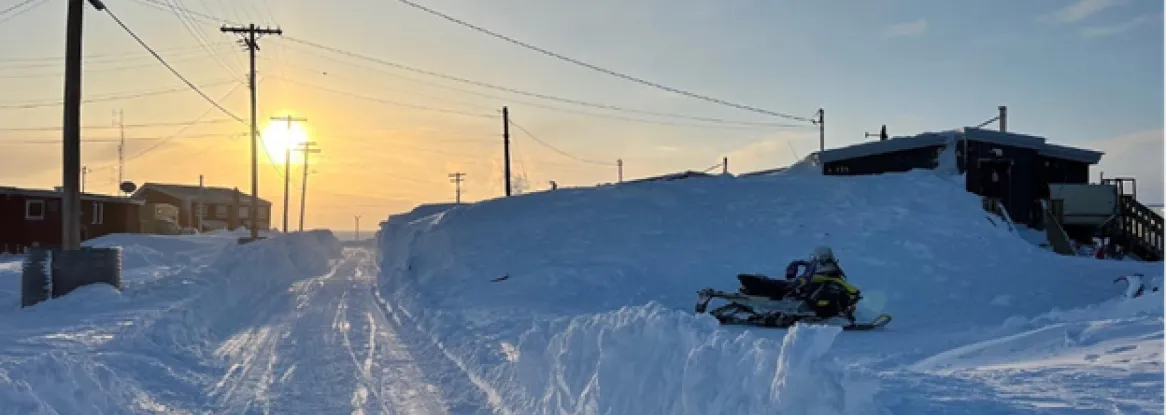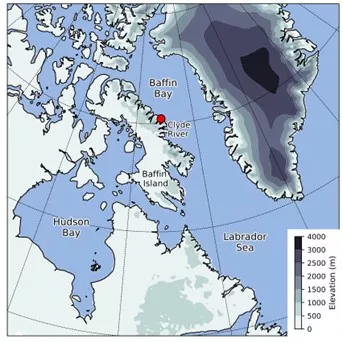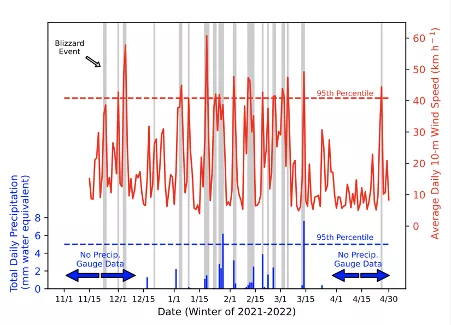By Brigitta Rongstad Strong
From November 2021 to April 2022, the community of Kangiqtugaapik (Clyde River) in Nunavut, Canada was slammed with thirty-three days of blizzard conditions, more than any winter since at least 1978-1979. Blustery storm after storm caused drifted snow to bury roads and homes, and cut off the community from vital services, such as water delivery and food delivery. Broken equipment hampered snow removal efforts, further compounding the impacts of the storms, and the community declared a state of emergency.
With limited access to resources, local people came together to dig out of the snow. But when winter turned to spring, questions remained: why was this winter so bad? And, how can the community better prepare for future extreme events? The answers required a collaborative investigation, with input from physical scientists, social scientists, and community members.
“We often talk about climate change as this abstract idea—we say the world has warmed by 1.1 degrees celsius,” said Alex Crawford, a research associate at the Center for Earth Observation Science at the University of Manitoba, Canada. “But one of the ways that climate change really manifests itself is through the extreme weather events that have major impacts on communities.”
Crawford is a part of a team of scientists and community partners from the Arctic Rain on Snow Study (AROSS) that came together to investigate the extreme events in 2021 and 2022 in Clyde River and the impacts on the people who live there, most of whom are Inuit.
The study, published in Weather, Climate, and Society, combines analyses of meteorological data and residents’ experiences and knowledge. The work reveals potential links to climate change and shares recommendations for addressing climate-induced risks in remote Arctic communities.
“Communities like Clyde River have been saying for many years that they need more access to locally-relevant information about weather, ice, and other environmental conditions and at scales that are important to them,” said Shari Fox, lead author of the paper, formerly a research scientist at the National Snow and Ice Data Center (NSIDC), and an AROSS team member.
As the climate warms, precipitation and extreme weather events across the Arctic are expected to increase, threatening people’s livelihoods and the infrastructure that keeps remote communities running. Cross-disciplinary and collaborative work can help communities identify their risks and vulnerability to climate change. This kind of research can also help identify steps that can be taken to support communities as they prepare and build resilience toward future environmental challenges.
“Communities across the Arctic experience extreme weather in complex ways,” said Matthew Druckenmiller, a research scientist with NSIDC and AROSS team member. “Teasing this out at the local scale, with local partners, is needed to connect our science with what matters in communities.”
Measurements from the atmosphere to the ground
Clyde River is situated along the eastern coast of Baffin Island, which frequently experiences high winds and heavy precipitation. Winter storms in this region are typically driven by broad-scale atmospheric patterns over the Arctic and North Atlantic Ocean. When a low pressure system in northeastern Canada pulls moisture from the Atlantic Ocean or Hudson Bay, rain or snow falls over the region. When a high pressure system moves in at the same time, settling over Greenland, a strong pressure gradient forces winds to barrel toward Clyde River. Under these conditions, precipitation and winds typically go hand-in-hand, setting the stage for harsh winter storms.
People often use the terms ‘blizzard’ and ‘snowstorm’ interchangeably, but blizzards aren’t constrained to times when winter storms drop a large amount of snow. Typically, blizzards are characterized by reduced visibility and high winds, rather than the source of snow. Blizzard conditions can be triggered by actively falling snow or wind-blown snow.
“With a winter storm, you’re more worried about the impact on mobility and visibility. You have to shut down the airport if you can't see far enough in front of you to land,” Crawford said. “A blizzard might only produce two feet of snow, but the snow might actually look like four feet in some places if high winds moved it around.”
In the case of the 2021-2022 winter in Clyde River, Crawford and his collaborators found that although snow fell during each blizzard event, the accumulated snowfall was generally low. High winds, however, were much more common. When the team analyzed the meteorological data from the 2021-2022 winter alongside the record going back to April 1978, they found that more than half of the blizzard events were characterized by extreme winds.
“You definitely get a different answer when looking at wind versus snow,” Crawford said. “The thing that really made this winter bad was that there were a lot of events with high winds in quick succession.”
Research suggests that Arctic precipitation will increase as the world warms, but the data are less clear about how winds and the number of blizzards in the region might change. Another complication is that the percentage of precipitation that falls as rain (instead of snow) will increase with warming. Crawford stresses that even if average snowfall declines, extreme winter events are something remote Arctic communities will face well into the future. “You don’t need extreme snowfall amounts, you need extreme winds,” he said. “Therefore, as long as you have enough snow to blow around, you can have another winter like this.”
Community knowledge fills physical science gaps
Physical science approaches, like the AROSS team’s analysis of the meteorological data from Clyde River, can reveal the mechanisms behind extreme events and the risk of more in the future. But an important piece of the puzzle remains—how prepared a community is to respond and recover.
“When considering the community impacts of future events, it’s not just a question of how often extreme events occur,” Crawford said. “There’s also the unique characteristics of the community being impacted. How resilient is the community? What resources do they have to expedite recovery?”
Local observations are vital for understanding the impacts of and building resilience to Arctic climate change, including extreme weather events. For the team investigating the events in Clyde River, news reports and first-hand accounts of the 2021-2022 winter not only provided valuable insight into people’s experiences, but also helped identify critical challenges and threats the community might face in the future and how to overcome them.
“We knew it was windy and we knew it snowed just enough to cause drifting,” Crawford said. “But until we talked with community members, we didn’t know exactly what people experienced on the ground.”
Through news reports, social media, and conversations with the AROSS team, local observations shed light on issues that physical science would have missed in terms of full understanding of the impacts. For example, broken equipment hampered snow clearing efforts, forcing the community to come together to dig out by hand. The delay meant that water and sewage trucks couldn’t get to many homes, and by February 2022, some families had gone almost a week without running water. The snow also hampered food delivery, and in March, shelves in the town’s only store were mostly empty.
These details aren’t typically recorded at weather stations, but they are important for scientists hoping to gain a more holistic view of extreme events and local impacts. Local observations are also essential for Arctic communities as they plan and prepare for their future in a warming world.
Using knowledge and insight shared by Clyde River residents, the AROSS team outlined recommendations to better support Arctic communities in the face of a warming climate, including: increasing snow removal capabilities and training opportunities for snow removal equipment operators; working with local experts and residents to develop and deliver relevant weather services and information; and ensuring communities have access to adequate funding to support these efforts.
Cross-disciplinary work supports community needs, advances Arctic science
Studies that weave together physical science and community knowledge and experiences help make science more applicable to communities in the Arctic. If the AROSS team had constrained their investigation into the 2021-2022 winter in Clyde River to snowfall amounts, and not incorporated local accounts of the events, a very different picture would have emerged—one that would have overlooked the experiences of people in the community.
“Communities like Clyde River need to be fully included and provide leadership as we develop better information and services,” Fox said. “Inuit knowledge is critical to this process.”
As the AROSS team continues their work, they are committed to collaborations with Arctic communities that help shed light on how Arctic residents are dealing with and adapting to climate change.
“Collaborating to tell these stories paints a more accurate picture of what we are dealing with as climate warms and what policymakers must address to support Arctic peoples,” Druckenmiller said.



